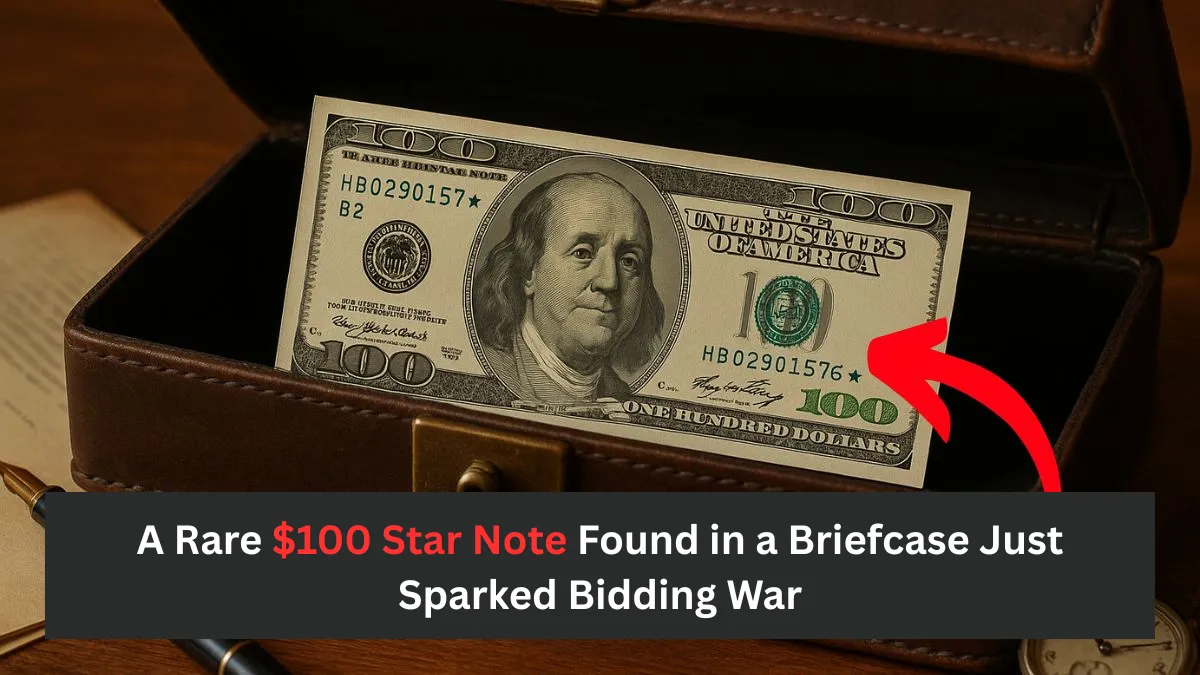The Incredible Discovery: $100 Star Note Sparks Bidding Frenzy
In a remarkable turn of events that could easily be mistaken for a movie plot, a rare $100 star note was recently uncovered inside an old briefcase, setting off a fierce bidding competition among collectors. The bill, printed many years ago, was found in an almost untouched state, maintaining its crispness and pristine condition.
What makes this particular note extraordinary isn’t just its vintage or condition but the fact that it is a “star note”—a unique replacement currency that is considerably rarer than typical U.S. bills. Once the discovery became public, collectors and investors quickly seized the chance to bid, driving the price into the five-figure range within just a few days.
The briefcase was reportedly acquired at an estate sale, long forgotten and untouched. The previous owner was completely unaware that it held such a numismatic gem. This incident highlights how seemingly ordinary currency can carry immense value, especially when it possesses rare printing characteristics or error features that ignite collectors’ enthusiasm.
What Is a Star Note and Why Is It So Valuable?
A star note is a special kind of currency issued by the U.S. Bureau of Engraving and Printing as a replacement for misprinted or defective bills. Instead of recycling the original serial number, the replacement bill receives a new serial number marked with a star symbol at the end. These replacement notes are printed in limited quantities, making them significantly more collectible—particularly in higher denominations like $100 or when they display unusual serial number traits.
The value of star notes increases dramatically due to their rarity combined with excellent condition. A $100 star note that has never circulated and remains crisp, without any creases or marks, can fetch a substantial premium at auctions. Certain collectors specifically target “low print run” star notes where only a handful of replacements were printed.
When these factors are paired with collector demand for certain series or years, it often results in intense bidding battles—such as the one currently underway.
How Much Could This $100 Star Note Be Worth?
Estimates for the worth of this discovered star note vary, but experts believe it could range from $10,000 up to $50,000 depending on the note’s series, condition, and unique serial number pattern. Some exceptionally rare star notes have even sold for over $100,000 at prestigious auctions. Collectors place the highest value on:
- Notes in uncirculated condition, graded 65 or above
- Rare series years or printing districts
- Eye-catching serial numbers such as repeating digits, palindromes, or very low numbers (like 00000012*)
- Extremely limited replacement print runs
If the bill inside the briefcase fits multiple desirable criteria—such as being from a rare series and featuring a fancy serial number—it’s no surprise that top collectors are eager to raise the price. Currently, private offers are coming in from bidders around the world, confirming that paper money can hold unexpectedly high value.
What This Find Means for Collectors and Everyday People
This discovery serves as a strong reminder that valuable currency might be hiding right under your nose. Whether you inherit a collection, find something at an estate sale, or simply stumble upon old bills in a drawer, it’s worthwhile to take a closer look.
Star notes are actually more common than many realize, yet few understand their significance or why collectors prize them. Even star notes that show some wear or have circulated can be worth several times their face value, especially when they come in larger denominations such as $50 or $100.
If you happen to find a star note, especially one in excellent shape, it’s wise to have it professionally graded by a service like PMG (Paper Money Guaranty). You might be holding a note worth thousands of dollars. For collectors, this find is a thrilling confirmation of the excitement behind currency hunting—and a great reason to examine your old bills tonight.
Conclusion: Your Forgotten Bill Could Be a Fortune
The tale of a $100 star note discovered in an old briefcase that quickly turned into a hot auction item is more than just an intriguing headline—it’s a call to action for both collectors and casual savers. Star notes, particularly in higher denominations, represent a lesser-known but potentially lucrative area of collecting.
If you’ve ever kept a bill that looked unusual or had a star symbol on it, now is the perfect time to get it evaluated. That seemingly ordinary $100 bill tucked away in your drawer could actually be your ticket to a surprising fortune.
FAQs
Q1: What is a star note?
A star note is a replacement banknote printed by the U.S. Treasury when an error occurs; it’s denoted by a star at the end of the serial number.
Q2: How do I know if my $100 bill is valuable?
Look for a star in the serial number, uncirculated condition, rare series years, and low or fancy serial numbers. These can significantly increase its value.
Q3: Are star notes common?
They’re not extremely rare, but low-print run star notes and higher denomination ones like $100 bills are much more desirable and valuable.
Q4: Where can I sell a valuable star note?
You can sell through currency auctions, collector forums, or certified marketplaces like Heritage Auctions or Stack’s Bowers after professional grading.
John M. Moody is a passionate writer known for his insightful and engaging storytelling. With a background in astrology and a love for exploring the human experience, John weaves cosmic wisdom into compelling narratives that inspire and enlighten. His work spans articles, essays, and spiritual guides, often blending mystical themes with real-life reflections. When he's not writing, John enjoys stargazing, reading mythology, and connecting with nature for creative inspiration.
